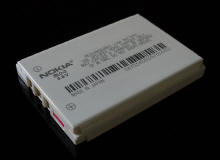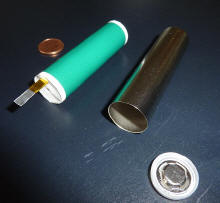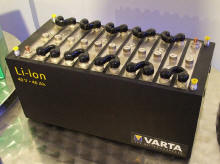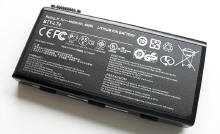Lithium-ion Battery
|
A lithium-ion battery (sometimes Li-ion battery or LIB) is a type of rechargeable battery in which lithium ions move from the negative electrode to the positive electrode during discharge, and reversely when charging. During discharge the negative electrode is the anode where oxidation takes place and during charge it turns into the cathode where reduction takes place. This functional meaning of the words anode and cathode is however widely ignored in the slang of battery-specialists: "anode" means negative electrode and "cathode" means positive electrode. For consistency, the latter practice is followed in this article. Different types of lithium-ion batteries use different chemistry and have different performance, cost, and safety characteristics. Unlike lithium primary batteries (which are disposable batteries), lithium-ion cells use an intercalated lithium compound as the electrode material instead of metallic lithium. Lithium-ion batteries are common in consumer electronics. They are one of the most popular types of battery for portable electronics, with one of the best energy-to-weight ratios, no memory effect, and a slow loss of charge when not in use. In addition to uses for consumer electronics, lithium-ion batteries are growing in popularity for defense, electric vehicles, and aerospace applications due to their high energy density. However, certain kinds of mistreatment may cause conventional lithium-ion batteries to explode. Charge and dischargeDuring discharge, the current flowing within the battery is carried by the movement of lithium ions (Li+) from the negative to the positive electrode, through the non-aqueous electrolyte and separator diaphragm. During charging, an external electrical power source (the charging circuit) applies a higher voltage (but of the same polarity) than that developed by the battery chemistry, forcing the current to pass in the reverse direction. The lithium ions then migrate from the positive to the negative electrode, where they become embedded in the porous electrode material in a process known as intercalation. ConstructionThe three primary functional components of a lithium-ion battery are the anode, cathode, and electrolyte. The anode of a conventional lithium-ion cell is made from carbon, the cathode is a metal oxide, and the electrolyte is a lithium salt in an organic solvent. Commercially, the most popular material for the anode is graphite. The cathode is generally one of three materials: a layered oxide (such as lithium cobalt oxide), one based on a polyanion (such as lithium iron phosphate), or a spinel (such as lithium manganese oxide). The electrolyte is typically a mixture of organic carbonates such as ethylene carbonate or diethyl carbonate containing complexes of lithium ions. These non-aqueous electrolytes generally use non-coordinating anion salts such as lithium hexafluorophosphate (LiPF6), lithium hexafluoroarsenate monohydrate (LiAsF6), lithium perchlorate (LiClO4), lithium tetrafluoroborate (LiBF4), and lithium triflate (LiCF3SO3). Depending on the choice of material for the anode, cathode, and electrolyte, the voltage, capacity, life, and safety of a lithium-ion battery can change dramatically. Recently, novel architectures have been employed to improve the performance of these batteries. Pure lithium is very reactive. It will vigorously react with water to form lithium hydroxide and hydrogen gas is liberated. Thus a non-aqueous electrolyte is used, and water is rigidly excluded from the battery pack by using a sealed container. HistoryLithium-ion batteries were first proposed by M.S. Whittingham (Binghamton University), at Exxon, in the 1970s. Whittingham used titanium(II) sulfide as the cathode and lithium metal as the anode. The electrochemical properties of the lithium intercalation in graphite were first discovered in 1980 by Rachid Yazami et al. at the Grenoble Institute of Technology (INPG) and French National Centre for Scientific Research (CNRS) in France. They showed the reversible intercalation of lithium into graphite in a lithium/polymer electrolyte/graphite half cell. Their work was published in 1982 and 1983. It covered both the thermodynamics (staging) and the kinetics (diffusion) aspects of the lithium intercalation into graphite together with reversibility. Primary lithium batteries in which the anode is made from metallic lithium pose safety issues. As a result, lithium-ion batteries were developed in which the anode, like the cathode, is made of a material containing lithium ions. In 1981, Bell Labs developed a workable graphite anode to provide an alternative to the lithium battery. Following groundbreaking cathode research by a team led by John Goodenough, the first commercial lithium-ion battery was released by Sony in 1991. The cells used layered oxide chemistry, specifically lithium cobalt oxide. These batteries revolutionized consumer electronics. In 1983, Michael Thackeray, John Goodenough, and coworkers identified manganese spinel as a cathode material. Spinel showed great promise, since it is a low-cost material, has good electronic and lithium ion conductivity, and possesses a three-dimensional structure which gives it good structural stability. Although pure manganese spinel fades with cycling, this can be overcome with additional chemical modification of the material. Manganese spinel is currently used in commercial cells. In 1989, Arumugam Manthiram and John Goodenough of the University of Texas at Austin showed that cathodes containing polyanions, e.g. sulfates, produce higher voltages than oxides due to the inductive effect of the polyanion. In 1996, Akshaya Padhi, John Goodenough and coworkers identified the lithium iron phosphate (LiFePO4) and other phospho-olivines (lithium metal phosphates with olivine structure) as cathode materials for lithium-ion batteries. LiFePO4 is superior over other cathode materials in terms of cost, safety, stability and performance, and is most suitable for large batteries for electric automobiles and other energy storage applications such as load saving, where safety is of utmost importance. It is currently being used for most lithium-ion batteries powering portable devices such as laptop computers and power tools. In 2002, Yet-Ming Chiang and his group at MIT published a paper in which they showed a dramatic improvement in the performance of lithium batteries by boosting the material's conductivity by doping it with aluminum, niobium and zirconium, though at the time, the exact mechanism causing the increase became the subject of a heated debate. In 2004, Chiang again increased performance by utilizing iron-phosphate particles of less than 100 nanometers (nm) in diameter. This decreased the particle density by almost a hundredfold, increased the surface area of the electrode and improved the battery's capacity and performance. Commercialization of the iron-phosphate technology led to a competitive market and a patent infringement battle between Chiang and Goodenough. ElectrochemistryThe three participants in the electrochemical reactions in a lithium-ion battery are the anode, cathode, and electrolyte. Both the anode and cathode are materials into which, and from which, lithium can migrate. The process of lithium moving into the anode or cathode is referred to as insertion (or intercalation ), and the reverse process, in which lithium moves out of the anode or cathode is referred to as extraction (or deintercalation). When a lithium-based cell is discharging, the lithium is extracted from the anode and inserted into the cathode. When the cell is charging, the reverse process occurs: lithium is extracted from the cathode and inserted into the anode. Useful work can only be extracted if electrons flow through a (closed) external circuit. The following equations are written in units of moles, making it possible to use the coefficient x. The cathode half-reaction (with charging being forwards) is: The anode half reaction is: The overall reaction has its limits. Overdischarge will supersaturate lithium cobalt oxide, leading to the production of lithium oxide, possibly by the following irreversible reaction: Overcharge up to 5.2 V leads to the synthesis of cobalt(IV) oxide, as evidenced by x-ray diffraction In a lithium-ion battery the lithium ions are transported to and from the cathode or anode, with the transition metal, cobalt (Co), in LixCoO2 being oxidized from Co3+ to Co4+ during charging, and reduced from Co4+ to Co3+ during discharge. Cathodes
Anodes
ElectrolytesThe cell voltages given in the Electrochemistry section are larger than the potential at which aqueous solutions would electrolyze. Therefore, nonaqueous solutions are used. Liquid electrolytes in lithium-ion batteries consist of lithium salts, such as LiPF6, LiBF4 or LiClO4 in an organic solvent, such as ethylene carbonate. A liquid electrolyte conducts lithium ions, acting as a carrier between the cathode and the anode when a battery passes an electric current through an external circuit. Typical conductivities of liquid electrolyte at room temperature (20 °C) are in the range of 10 mS/cm (1 S/m), increasing by approximately 30–40% at 40 °C and decreasing by a slightly smaller amount at 0 °C. Unfortunately, organic solvents are easily decomposed on anodes during charging. However, when appropriate organic solvents are used as the electrolyte, the solvent is decomposed on initial charging and forms a solid layer called the solid electrolyte interphase (SEI), which is electrically insulating yet sufficiently conductive to lithium ions. The interphase prevents decomposition of the electrolyte after the second charge. For example, ethylene carbonate is decomposed at a relatively high voltage, 0.7 V vs. lithium, and forms a dense and stable interface. Advantages and disadvantagesAdvantages
Disadvantages of traditional Li-ion technologyShelf life
Internal resistanceThe internal resistance of lithium-ion batteries is high compared to other rechargeable chemistries such as nickel-metal hydride and nickel-cadmium. Internal resistance increases with both cycling and chronological age. Rising internal resistance causes the voltage at the terminals to drop under load, which reduces the maximum current that can be drawn. Eventually the internal resistance reaches a point at which the battery can no longer operate the equipment for an adequate period. High drain applications such as power tools may require the battery to supply a current that would drain the battery in 4 minutes if sustained (e.g. 22.5 A for a battery with a capacity of 1.5 A·h). Lower-power devices such as MP3 players may draw low enough currents to run for 10 hours on a charge (e.g. 150 mA for a battery with a capacity of 1500 mA·h). With similar battery technology, the MP3 player's battery will last longer since it can tolerate a higher internal resistance. To power larger devices, such as electric cars, connecting many small batteries in a parallel circuit is more efficient than connecting a single large battery. Safety requirementsLi-ion batteries are not as durable as nickel metal hydride or nickel-cadmium designs, and can be dangerous if mistreated. They may suffer thermal runaway and cell rupture if overheated or charged to an excessively high voltage. In extreme cases, these effects may be described as "explosive." Furthermore, they may be irreversibly damaged if discharged below a certain voltage. To reduce these risks, lithium-ion batteries generally contain a small circuit that shuts down the battery when it is discharged below about 3 V or charged above about 4.2 V. In normal use, the battery is therefore prevented from being deeply discharged. When stored for long periods, however, the small current drawn by the protection circuitry may drain the battery below the protection circuit's lower limit, in which case normal chargers are unable to recharge the battery. More sophisticated battery analyzers can recharge deeply discharged cells by slow-charging them to reactivate the safety circuit and allow the battery to accept charge again. Other safety features are required for commercial lithium-ion batteries:
These devices occupy useful space inside the cells, reduce their reliability ,and permanently and irreversibly disable the cell when activated. They are required because the anode produces heat during use, while the cathode may produce oxygen. Safety devices and improved electrode designs greatly reduce or eliminate the risk of fire or explosion. These safety features increase the cost of lithium-ion batteries compared to nickel metal hydride cells, which only require a hydrogen/oxygen recombination device (preventing damage due to mild overcharging) and a back-up pressure valve. Many types of lithium-ion cell cannot be charged safely below 0 °C. Product recallsAbout 1% of lithium-ion batteries are recalled. Specifications and design
Because lithium-ion batteries can have a variety of cathode and anode materials, the energy density and voltage vary accordingly. Lithium-ion batteries with a lithium iron phosphate cathode and graphite anode have a nominal open-circuit voltage of 3.2 V and a typical charging voltage of 3.6 V. Lithium nickel manganese cobalt (NMC) oxide cathode with graphite anodes have a 3.7 V nominal voltage with a 4.2 V max charge. The charging procedure is performed at constant voltage with current-limiting circuitry (i.e., charging with constant current until a voltage of 4.2 V is reached in the cell and continuing with a constant voltage applied until the current drops close to zero). Typically, the charge is terminated at 3% of the initial charge current. In the past, lithium-ion batteries could not be fast-charged and needed at least two hours to fully charge. Current-generation cells can be fully charged in 45 minutes or less. Some lithium-ion varieties can reach 90% in as little as 10 minutes. Charging procedureStage 1: Apply charging current limit until the voltage limit per cell is reached. Stage 2: Apply maximum voltage per cell limit until the current declines below 3% of rated charge current. Stage 3: Periodically apply a top-off charge about once per 500 hours. The charge time is about three to five hours, depending on the charger used. Generally, cell phone batteries can be charged at 1C and laptop-types at 0.8C, where C is the current that would discharge the battery in one hour. Charging is usually stopped when the current goes below 0.03C but it can be left indefinitely depending on desired charging time. Some fast chargers skip stage 2 and claim the battery is ready at 70% charge. Laptop battery chargers sometimes gamble, and try to charge up to 4.35 V then disconnects the battery. This helps to compensate for the battery's internal resistance and charges up to 100% in short time. Top-off charging is recommended when voltage goes below 4.05 V/cell. Lithium-ion cells are charged with 4.2 ± 0.05 V/cell, except for military long-life cells where 3.92 V is used to extend battery life. Most protection circuits cut off if either 4.3 V or 90 °C is reached. If the voltage drops below 2.50 V per cell, the battery protection circuit may also render it unchargeable with regular charging equipment. Most battery protection circuits stop at 2.7–3.0 V per cell. For safety reasons it is recommended the battery be kept at the manufacturer's stated voltage and current ratings during both charge and discharge cycles. Variations in materials and constructionThe increasing demand for batteries has led vendors and academics to focus on improving the power density, operating temperature, safety, durability, charging time, output power, and cost of LIB solutions. Usage guidelinesProlonging battery pack life
Multicell devicesLi-Ion batteries require a Battery Management System to prevent operation outside each cell's Safe Operating Area (over-charge, under-charge, safe temperature range) and to balance cells to eliminate SOC mismatches, significantly improving battery efficiency and increasing overall capacity. As the number of cells and load currents increase, the potential for mismatch also increases. There are two kinds of mismatch in the pack: state-of-charge (SOC) and capacity/energy ("C/E") mismatch. Though SOC is more common, each problem limits pack capacity (mA·h) to the capacity of the weakest cell. SafetyLithium-ion batteries can rupture, ignite, or explode when exposed to high-temperature, e.g., prolonged direct sunlight. Short-circuiting battery causes cells to convert energy into heat. This creates an exothermic oxidizing reaction, raising the temperature hundreds of degrees in a fraction of a second. A chain reaction occurs when neighboring cells heat up, and in some cases, causing the entire battery to ignite or explode. Any attempt to open or modify the casing or circuitry can be dangerous. In the event of a fire, the device may emit a dense white smoke. The fumes may severely irritate the respiratory tract, eyes and skin. Replacing the lithium cobalt oxide cathode material in lithium-ion batteries with a lithium metal phosphate such as lithium iron phosphate improves cycle counts, shelf life and safety, but lowers capacity. Currently, these 'safer' lithium-ion batteries are mainly used in electric cars and other large-capacity battery applications, where safety issues are critical. Lithium-ion batteries normally contain safety devices to protect the cells from disturbance. However, contaminants inside the cells can defeat these safety devices. RecallsIn March 2007, Lenovo recalled approximately 205,000 batteries at risk of explosion. In August 2007, Nokia recalled over 46 million batteries at risk of overheating and exploding. One such incident occurred in the Philippines involving an Nokia N91, which uses the BL-5C battery. In December 2006, Dell recalled approximately 22,000 laptop batteries from the U.S. market. Approximately 10 million Sony batteries used in Dell, Sony, Apple, Lenovo/IBM, Panasonic, Toshiba, Hitachi, Fujitsu and Sharp laptops were recalled in 2006. The batteries were found to be susceptible to internal contamination by metal particles. Under some circumstances, these particles could pierce the separator, causing a short-circuiting. In October 2004, Kyocera Wireless recalled approximately 1 million mobile phone batteries to identify counterfeits. Transport restrictionsIn January 2008, the United States Department of Transportation ruled that passengers on board commercial aircraft could carry lithium batteries in their checked baggage if the batteries are installed in a device. Types of batteries affected by this rule are those containing lithium, including Li-ion, lithium polymer, and lithium cobalt oxide chemistries. Lithium-ion batteries containing more than 25 grams (0.88 oz) equivalent lithium content (ELC) are exempt from the rule and are forbidden in air travel. This restriction greatly reduces the chances of the batteries short-circuiting and causing a fire. Additionally, a limited number of replacement batteries may be transported in carry-on luggage. Such batteries must be sealed in their original protective packaging or in individual containers or plastic bags. In the fall of 2009, some postal administrations restricted air shipping (including EMS) of lithium and lithium-ion batteries, and products containing these (e.g. laptops, cell phones etc.). Among these countries are Hong Kong, and Japan. Some information extracted from Wikipedia, the free encyclopedia: Text is available under the Creative Commons Attribution-ShareAlike License; additional terms may apply. See Terms of Use for details. |




